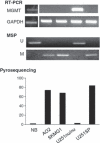Epigenetic aberrations and therapeutic implications in gliomas
- PMID: 20384628
- PMCID: PMC11159342
- DOI: 10.1111/j.1349-7006.2010.01545.x
Epigenetic aberrations and therapeutic implications in gliomas
Abstract
Almost all cancer cells have multiple epigenetic abnormalities, which combine with genetic changes to affect many cellular processes, including cell proliferation and invasion, by silencing tumor-suppressor genes. In this review, we focus on the epigenetic mechanisms of DNA hypomethylation and CpG island hypermethylation in gliomas. Aberrant hypermethylation in promoter CpG islands has been recognized as a key mechanism involved in the silencing of cancer-associated genes and occurs at genes with diverse functions related to tumorigenesis and tumor progression. Such promoter hypermethylation can modulate the sensitivity of glioblastomas to drugs and radiotherapy. As an example, the methylation of the O6-methylguanine DNA methyltransferase (MGMT) promoter is a specific predictive biomarker of tumor responsiveness to chemotherapy with alkylating agents. Further, we reviewed reports on pyrosequencing - a simple technique for the accurate and quantitative analysis of DNA methylation. We believe that the quantification of MGMT methylation by pyrosequencing might enable the selection of patients who are most likely to benefit from chemotherapy. Finally, we also evaluated the potential of de novo NY-ESO-1, the most immunogenic cancer/testis antigen (CTA) discovered thus far, as an immunotherapy target. The use of potent epigenetics-based therapy for cancer cells might restore the abnormally regulated epigenomes to a more normal state through epigenetic reprogramming. Thus, epigenetic therapy may be a promising and potent treatment for human neoplasia.
Figures




Similar articles
-
Concurrent hypermethylation of DNMT1, MGMT and EGFR genes in progression of gliomas.Diagn Pathol. 2012 Jan 20;7:8. doi: 10.1186/1746-1596-7-8. Diagn Pathol. 2012. PMID: 22264301 Free PMC article.
-
The global DNA methylation surrogate LINE-1 methylation is correlated with MGMT promoter methylation and is a better prognostic factor for glioma.PLoS One. 2011;6(8):e23332. doi: 10.1371/journal.pone.0023332. Epub 2011 Aug 4. PLoS One. 2011. PMID: 21829728 Free PMC article.
-
MGMT methylation analysis of glioblastoma on the Infinium methylation BeadChip identifies two distinct CpG regions associated with gene silencing and outcome, yielding a prediction model for comparisons across datasets, tumor grades, and CIMP-status.Acta Neuropathol. 2012 Oct;124(4):547-60. doi: 10.1007/s00401-012-1016-2. Epub 2012 Jul 19. Acta Neuropathol. 2012. PMID: 22810491 Free PMC article.
-
Gene regulation by methylation.Recent Results Cancer Res. 2009;171:217-39. doi: 10.1007/978-3-540-31206-2_13. Recent Results Cancer Res. 2009. PMID: 19322547 Review.
-
MGMT testing--the challenges for biomarker-based glioma treatment.Nat Rev Neurol. 2014 Jul;10(7):372-85. doi: 10.1038/nrneurol.2014.100. Epub 2014 Jun 10. Nat Rev Neurol. 2014. PMID: 24912512 Review.
Cited by
-
Epigenetic dysregulation in glioma.Cancer Sci. 2014 Apr;105(4):363-9. doi: 10.1111/cas.12379. Cancer Sci. 2014. PMID: 24843883 Free PMC article. Review.
-
Ten years of progress in vaccination against cancer: the need to counteract cancer evasion by dual targeting in future therapies.Cancer Immunol Immunother. 2011 Aug;60(8):1127-35. doi: 10.1007/s00262-011-0985-7. Epub 2011 Apr 9. Cancer Immunol Immunother. 2011. PMID: 21479639 Free PMC article. Review.
-
Correlation of MGMT promoter methylation status with gene and protein expression levels in glioblastoma.Clinics (Sao Paulo). 2011;66(10):1747-55. doi: 10.1590/s1807-59322011001000013. Clinics (Sao Paulo). 2011. PMID: 22012047 Free PMC article.
-
DNA methylation-regulated LINC02587 inhibits ferroptosis and promotes the progression of glioma cells through the CoQ-FSP1 pathway.BMC Cancer. 2023 Oct 17;23(1):989. doi: 10.1186/s12885-023-11502-0. BMC Cancer. 2023. PMID: 37848823 Free PMC article.
-
Histone Methylation by Temozolomide; A Classic DNA Methylating Anticancer Drug.Anticancer Res. 2016 Jul;36(7):3289-99. Anticancer Res. 2016. PMID: 27354585 Free PMC article.
References
-
- Jones PA, Laird PW. Cancer epigenetics comes of age. Nat Genet 1999; 21: 163–7. - PubMed
-
- Kondo Y, Issa JP. Epigenetic changes in colorectal cancer. Cancer Metastasis Rev 2004; 23: 29–39. - PubMed
-
- Jones PA, Baylin SB. The fundamental role of epigenetic events in cancer. Nat Rev Genet 2002; 3: 415–28. - PubMed
-
- Turker MS. The establishment and maintenance of DNA methylation patterns in mouse somatic cells. Semin Cancer Biol 1999; 9: 329–37. - PubMed
Publication types
MeSH terms
Substances
LinkOut - more resources
Full Text Sources
Medical
Research Materials

